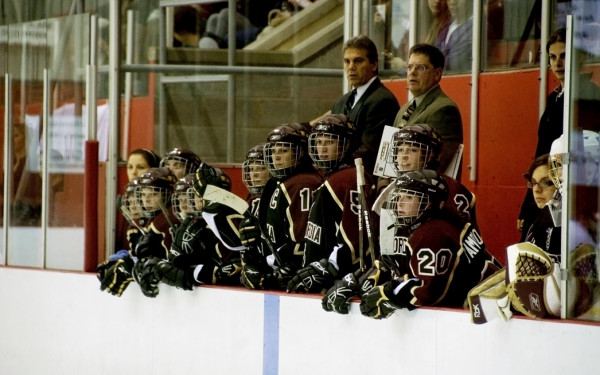The Pressure Is On
The Stress of Shootouts and Penalty Shots in Hockey
From the gruesome skating, the body-checks along the boards and the battles for the puck—playing a hockey game is always physically draining.
But when the game is still tied after that, then comes the most mentally exhausting part: the shootout. The whole arena is on its feet, screaming and shouting.
The pressure is on.
The shootout shot is the moment where hockey players test their skill one-on-one against goaltenders, where they must take on the pressure and score that all-important goal.
It is at moments like these that hockey heroes are made. Some players aren’t able to score those key goals because it’s simply too stressful, but others rise to the occasion and give their teams the win.
Stinger Kyle Armstrong, centre for Concordia’s men’s hockey team, sees shootouts and penalty shots as some of the most nerve-wracking moments in hockey.
“When I get asked by my coach to take a penalty shot in the game, a lot of emotions come over me,” said Armstrong. “As you stand there at centre ice, you can’t help but think about scoring on the goalie and helping your team win the game.”
There is no doubt that a standing crowd watching your every move is stressful, but Armstrong said that there are other things circling in the player’s mind.
“When you’re about to take a penalty shot during a game, it’s not so much the fans that put pressure on you, but the implications that the shot might have on the game,” explained Armstrong.
When the referee blows the whistle for Armstrong to take the shot, everything for him goes silent.
“I just focus on what I’m doing with the puck and hope it finds the back of the net,” he said. “You try not to let [the pressure] creep in your head before you take the shot, but it’s definitely hard not to.”
Dr. Lois Baron, a sports and educational psychologist at Concordia, believes that there is a lot of pressure coming from the results of the match, but thinks that all those staring at you have an additional impact when performing your finesse move.
“Nobody likes to fail. There is an element of judgment that is magnified when all eyes are on you,” Baron said.
“There are the expectations from within as well as from team members and the coach,” she added. “Now that’s pressure.”
But there are ways around it.
Armstrong’s tip to other hockey players is to find a specific move that feels most comfortable and practice it over and over again.
His move is pretty simple, he said.
“I’ve always been told by other goalies that the hardest thing to stop is quickness. So I try to come at the goalie with a lot of speed, make a quick move with my backhand and try to get the puck up as quickly as possible.”
“The most pressure you can have as a hockey player is being the last shooter in a shootout, and if you don’t score your team loses. When you shoot first it still matters, but everyone always remembers the last shooter.”
—Kyle Armstrong, Concordia Stingers Centre
That last part, Armstrong said, is key.
“When you come down the ice with speed and make a quick deke, the goalie instantly pus his pads on the ice,” leaving the top shelf wide open.
It’s not just the moves that count, however: the order of shooting is just as important to Armstrong, who, given the choice, would shoot first every time.
“Shooting first has way less pressure than shooting last because the game doesn’t necessarily rest on your shoulders,” he said. “Depending on when you shoot, it could be the difference between one or two points [in the standings]—which always has an effect on where the team places at the end of the season.
“The most pressure you can have as a hockey player is being the last shooter in a shootout, and if you don’t score your team loses. When you shoot first it still matters, but everyone always remembers the last shooter.”
As for Baron, her biggest suggestion is repetition: those who simulate real penalty shot sessions in practice will be able to better manage their thoughts come game day.
The most important thing for Armstrong, however, is simply taking a deep breath before going for the shot.
“It instantly relaxes all the nerves in your body […], puts your mind in a peaceful state and prepares you to execute whatever you’re trying to do,” he says.
Still, none of the above guarantees a goal every time.
“When I was in Midget and we were in the semifinals in the playoffs and I was chosen as the first shooter for my team […] I ended up trying a move that I had used in the game earlier and scored, but sadly it didn’t work [in the shootout],” said Armstrong.
But whenever that puck does makes it to the back of the net, only one thought passes through Armstrong’s mind–not personal pride, but what it means for the team.
“It’s a huge relief when you’ve scored the shootout goal because you know you’ve put your team in a position to possibly win the game,” he said.
However, there’s no doubt Armstrong gains more confidence from the experience, and brings it to the team’s next game.
“[Scoring] is a great feeling because the coach put trust in you to score that goal, so to come through gives him more confidence in you as a player,” said Armstrong. “It also gives you more confidence in your skills going into the next game because you’ve scored the goal.”

_721_477_90.jpg)


_(1)__600_375_90_s_c1.jpg)
__600_375_90_s_c1.jpg)
1webedit__600_375_90_s_c1.jpg)